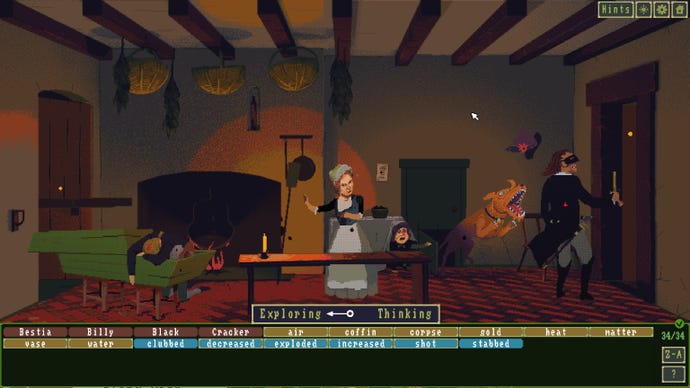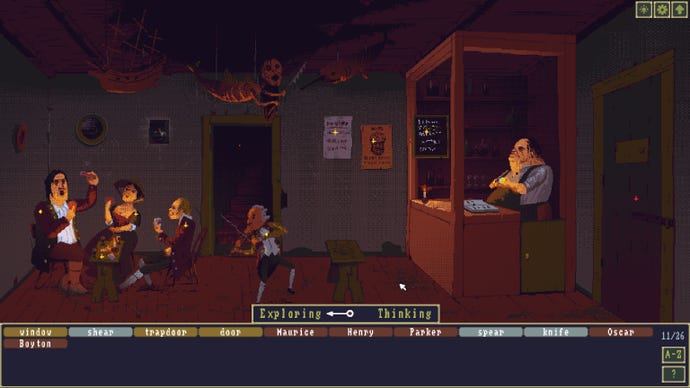The Case Of The Golden Idol review: a gripping detective game with echoes of Obra Dinn
Murders most foul
Detective games are often about filling in the blanks. A terrible crime will sit at the heart of them, yes, but most take place in the days and weeks that follow, where the bulk of your time is spent gathering clues and building a case to work out whodunnit. Rarely do you get to glimpse the immediate aftermath of the crime itself, where all the major suspects are still in play and their pockets are stuffed with incriminating evidence they'll no doubt be disposing of in the coming minutes.
The prime exception to this rule is Lucas Pope's Return Of The Obra Dinn, which gives you a time-travelling pocket watch to revisit the scenes of its many, many murders and work out exactly what happened to its 60-strong passenger list on its titular, ill-fated ship. Frogwares' Sherlock Holmes games and their mind palace visualisation techniques also warrant a mention here, and maybe even Outer Wilds at a push, if you count its 22-minute timeloop as an investigation scene several millennia in the making. But it's Obra Dinn that Color Gray Games emulate most strongly with their impressive debut in The Case Of The Golden Idol, which gives you a series of 12 murders to solve, each of which is presented as a freeze-frame vignette at the moment of death. You're still filling in blanks here, slotting names, objects and eventually verbs in its various scene scrolls to deduce whodunnit and howtheydunit, but this intriguing tale of 18th century high (and a secret) society, betrayals, backstabbing and murder most foul is a mystery game for the ages.
There is no need for magical pocket watches in this particular case. Instead, Color Gray Games simply cast you as a kind of detached, omniscient detective figure, able to swoop into these scenes and observe them objectively without having any stake in the events themselves. It neatly sidesteps the issue of explaining why you're present at these scenes – and who you're gathering these so-called scrolls for – and just lets you get on with enjoying the cerebral nature of its murderous puzzles.
And what puzzles they are. Color Gray Games have assembled a variety of artfully drawn scenarios here, from garden parties gone wrong to court-based virtue trials and lighthouse miracles to name just a few, each of them more intricate and ingenious than the last. You'll likely speed through earlier cases, but the late-game murders are complex, multi-screen affairs where you'll need to connect several, seemingly disparate dots to arrive at the correct conclusion.

For all of their clever clue drops, however, there is sadly no evidence of Obra Dinn's galaxy brain theorising to be found here. There is one solution, and one solution only to each of these cases, and you'll arrive at it exactly the same way each time you play. There will be no socks vs shoe heel debates to determine who's who in The Case Of The Golden Idol (although the latter do feature in the aforementioned lighthouse scene), but to be honest, I'm fine with that. Even if there's less room for player expression, Colour Gray Games have still prepared a caseload of brain-teasingly good crimes to solve here, and many had me staring at my screen for a good 15-30 minutes, just trying to absorb what clues were in front of me and how they all fitted together.
Each case is split into two halves, you see. The first, and easily most exciting part is when you're 'exploring' the case in question. Here, you'll nose through scenes in point and click fashion, rifle through pockets, bins, secret compartments and other bits of furniture, and absorb other great visual clues, all so you can gather them together to ready yourself for the second part of each case: the 'thinking' window, which you can flick over to at any point using the lower menu tab.

This thinking screen is mostly blank when you first begin a case, but its various scrolls will gradually fill themselves in with more information as you progress with your exploring. You only need to fill out the first one describing the chain of events in order to actually complete each case, I should add. The rest, such as character identities and other little puzzles present throughout the scene are wholly optional. The latter are often quite critical in actually working out whodunnit, though, and are worth filling in just for the sake of it. After all, who doesn't like a big green tick over their homework, eh?
The way the thinking screen fills out over time, though, exposes The Case Of The Golden Idol's one main weakness: and that's whether to highlight, or not to highlight, its pertinent clues. You have the option to leave them unmarked if you prefer a more pixel-hunting style sleuth approach, but I ended up finding this too frustrating, opting instead for the developer-recommended highlights. Admittedly, having all the relevant clues underlined does take some of the fun and challenge out of the exploring process somewhat, as it means you can simply rinse through a scene relatively quickly and have everything you need to sit down and solve it without much effort.



Over time, though, I realised that figuring out what to do with said clues still requires a significant amount of deduction on the part of the player, and simply being able to gather clues quickly did not mean I was able to solve it any faster. After all, until that thinking board gets filled out with its respective challenge scrolls, it's hard to know what's important and what's not – and I know I'm the type of person who'd rather stack my hand early on, so to speak, so I can lay all my cards on the table to tackle the problem head on. So I grew to enjoy and appreciate the ease of Golden Idol's clue gathering, and once enough time has passed, I can definitely see myself going back for another playthrough without highlights this time to inject some of the challenge back in. For first-time players, however, I'd strongly recommend going full highlights.
Indeed, there was no amount of underlining that could prepare me for some of its late-game puzzle solutions. While most cases are very artfully constructed, both in terms of their visual design and their spiderweb-like trails of evidence, there were a few instances where its leaps of logic went one step too far, leaving me genuinely stumped on how I would have worked it out. Some I'll own up to just being a bit too thick to fully comprehend at the time, and because I stoutly refused to use its built-in hint system (and the game's persistent 'are you really, really sure?' screens didn't seem to want me to, either, in fairness), there were a handful of times where I cheesed the answer into existence through sheer guesswork. A scroll will flash red if you've filled it out incorrectly, for example, but the error message will adopt a shade of yellow if only one or two words need replacing. It's at this stage where it's easy to become a bit lazy, slotting in different words by process of elimination to get the right solution.

Admittedly, I am also the type of person who sometimes gets blinkered when I'm absolutely sure I've arrived at the correct answer. When this happens, my brain simply cannot conceive there might be another solution – a problem that is entirely of my own making, but then I think back to Return Of The Obra Dinn again and marvel afresh at how it managed to cater for so many different styles of problem-solving. The Case Of The Golden Idol has a much narrower lens through which to view its dozen murders, but as I mentioned earlier, I think I'm okay with that. After all, we can't all be Sherlock Pope, can we?
Rather, The Case Of The Golden Idol has more of a John Watson vibe – a few steps behind their resident super sleuth, but always in the same ball park, and that's what counts here, I think. This is certainly the closest I've seen another game try and emulate Obra Dinn's grisly murder sketches, and the fact it does them so well, and with such a keen eye for detail and visual flourish, is a credit to Color Gray Games' two-strong dev team. Its gurning cast of ne'er-do-wells may not be quite as nuanced as their nautical rivals, but they'll definitely stick just as long in your little grey cells. And if you've been very close attention, you'll now be able to fill out these blanks right here: The _____ Of The _____ _____ is _____ and I _____ it to bits.










